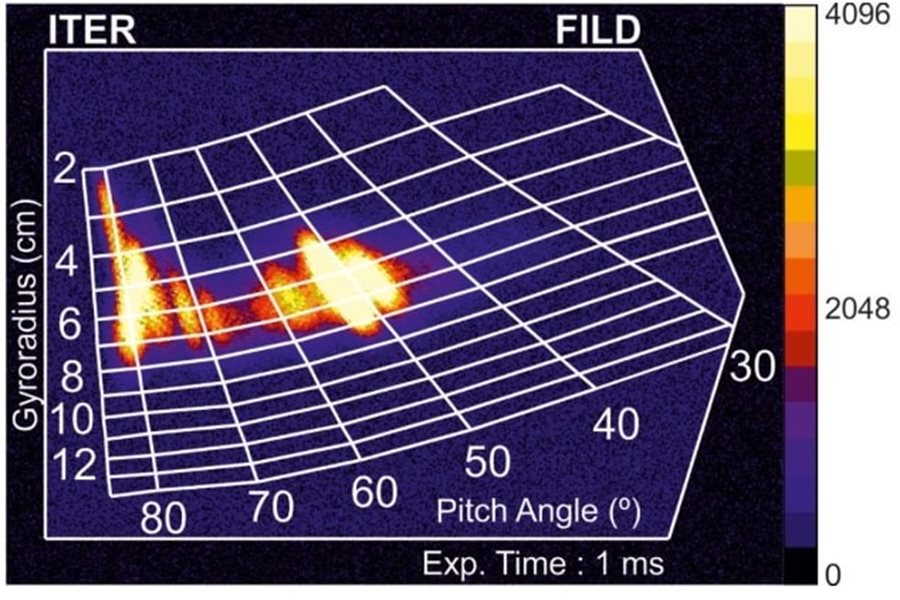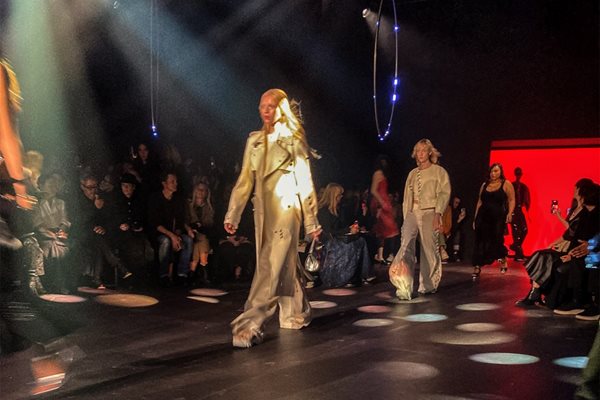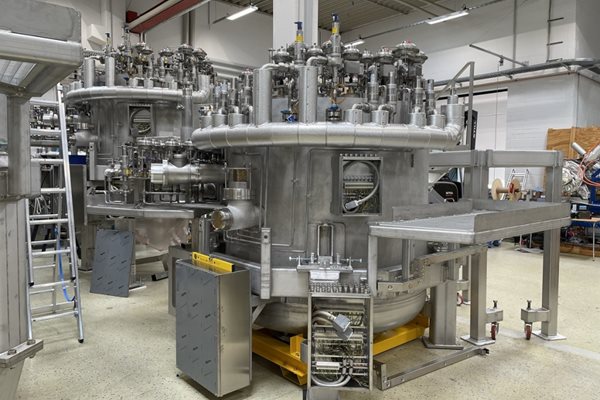
you're currently reading the news digest published from 26 Sep 2022 to 03 Oct 2022
featured3
of-interest1
press30
featured
Diagnostics | Measuring the behaviour of fast ions in the plasma
A diagnostic probe, called the "lost alpha monitor," is being carefully designed to measure the behaviour of escaping ions. The lost alpha monitor will be part of the system that measures fast ions escaping from the ITER plasma. These ions are generated in the core plasma by fusion reactions (alpha particles) and plasma heating systems. Due to various plasma instabilities, the fast ions can escape the core plasma and ultimately hit ITER plasma facing components. Maximizing fast ion confinement will help the ITER Project reach its objectives. As the fast ions escape the core, they remove energy, thereby reducing plasma performance. When they reach a high enough flux, they can also damage the reactor first wall. The purpose of measuring these particles in ITER is to gain understanding as to how fast ions are transported to the edge plasma by plasma instabilities. Knowing how escaping fast ions are produced will help design tokamaks that minimize their occurrence—something that will be necessary for DEMO and subsequent commercial fusion devices. The lost alpha monitor diagnostic probe will sample populations of the fast particles to figure out what their energies are. This analysis will be correlated with what is known about the current state of the plasma and hence improve the models that predict how plasma instabilities generate escaping fast ions. An existing diagnostic adapted to ITER "ITER diagnostics are normally passive, in the sense that they stay far behind the first wall," says Martin Kocan, Diagnostics Coordinating Scientist in the Ex-Vessel Diagnostics Section. "But we couldn't find an approach that would make passive measurements work for fast ions. So we are designing an active system—a detector that comes into the very edge of the plasma." "We are planning to develop a movable probe, which has a six-metre-long shaft driven by an electric motor to push the probe into the very edge of the plasma. That's roughly at the level where the ITER first wall is. At the tip of this moving system will be a probe head with a small pinhole, through which ions will pass. Inside this probe head, we will have what we call a scintillator plate, which is a 2-dimensional array based on special material that emits visible light when hit by energetic ions." "If you could peer inside the probe head you would see a plate with patches of light where ions hit. A system of mirrors will transfer the image from the scintillator to a fast-framing camera. The position of the light on the scintillator tells you the energy and velocity of the ions." This kind of diagnostic probe is already used in fusion reactors around the world, where they are officially referred to as "fast ion loss detectors." The concept is well understood, but ITER has some unique features that require innovation. For example, for ITER needs to deploy a rugged scintillator so that it can survive plasma radiation over many years of operation. The scintillator will be backed by an array of electric detectors, called Faraday cups, which will provide similar information, should the scintillator performance degrade over time. Also, at ITER there is much stronger emphasis on preventing damage to the movable probe that could result in reactor down time. ITER refers to this system as the "lost alpha monitor" because the diagnostic was originally intended for the measurement of helium ions (alpha particles) produced by fusion reactions and 'lost' in the plasma periphery. However, the diagnostic can sample any fast ions with mega electron volt energies ejected from the core plasma. "To design this system, we established new collaborations with the UKAEA [the UK Autonomic Energy Authority] and the University of Seville in Spain," says Kocan. "Both of these partners have strong experience with this kind of diagnostic and the associated engineering. We also work with EUROfusion and Aalto University in Finland on the modelling for this diagnostic." A design that is safe and robust During operations, other systems will detect whether fast ions are being produced. Then a decision can be made to either plunge the probe into the reactor during the same pulse, or to repeat the pulse again and deploy the probe at the right time next time. The probe will go in for a second or two and then retract back to a safe position to avoid overheating. One design alternative would be to have a diagnostic permanently in place. But that would require water cooling, which carries a risk. A pipe in a moving system could break and leak—and then operations would have to stop to remove the port, find the leak, and repair it. Design features were specifically added to make sure a failure inside the diagnostic would not stop ITER operation. For example, one set of features prevents the system from going deeper than a shallow position at the very edge of the plasma. Another set of features prevents the operator from damaging the tokamak by inadvertently mis-typing the position or by entering a position based on an incorrect assessment of where the plasma is. And a third way of preventing shutdown is that if the motor that drives the probe fails, the system can still be retracted and closed off, without losing important machine operation time. "Not only do we need this lost alpha monitor to inform future tokamak designs, but it is also important for the operation of ITER," emphasizes Kocan. 'We will optimize the design and ensure that it forms part of the eyes and ears of ITER.'
Fusion fashion | A collision of worlds
As Gabriela Hearst, the Creative Director of the fashion brand Chloé, is quick to tell you, she is very excited about hydrogen fusion. She had read about ITER and other fusion projects in an article in the Financial Times in 2021, which sparked her imagination. Always in search of new inspiration and innovative approaches to sustainability, she organized a visit to ITER with her creative team. This visit, and her research into fusion in all its forms, including at Commonwealth Fusion Systems and Helion, inspired her Spring-Summer 2023 collection, revealed last week during the Paris Fashion Week. A day before the Chloé show, Hearst invited representatives from fusion to meet with her team and fashion journalists to explain the link between fusion and fashion, which is, admittedly, not immediately apparent. Explaining her fascination with fusion and its link to her new line, Hearst said, 'The focus of our research was fusion energy as a large-scale, peaceful, clean energy source. What I didn't expect to experience from our visits to ITER (public sector), Commonwealth Fusion Systems and Helion (private sector) was the powerful passion that overtook me to tell the good news to everyone that would listen. The energy that moves our universe will, in the not-so-distant future, help power our world and solve many of our concerns today.' She added, 'To me, sustainability is an energy issue ... and until we find a way to get ourselves out of fossil fuels and coals, which move this world around 85% of the time, we're done.' When asked what he thought about Hearst's passion for fusion, ITER's Head of Communications Laban Coblentz replied frankly, 'I know very little about fashion, and to be honest when Gabi wrote to ask about visiting ITER, I will admit that I didn't know who she was. But when she and her team visited ITER, I was stunned because she was the most well-educated layperson on the topic of fusion I had ever met. You could see, on the worksite tour, that she was familiar with the components and features from her reading. It was an inspiring collision of worlds.' Tokamak references were incorporated into the circular designs of the cut-outs in the clothing, the accessories, and even into metallic buttons that resembled components. Isotope shapes were interpreted as rivets on denim. Even the runway was in the form of a donut, with a pink-plasma-hued light show shining circles around the models, and hanging LED rings that pulsed with light and were placed similarly to a tokamak's vertical coils. Hearst is well-versed in using her platform of fashion to address global challenges and is at the forefront of sustainability in the fashion industry—which, according to the World Bank, is responsible for 10% of global carbon emissions. Although fashion can seem like a distant world to some scientists and engineers, its impact and reach are indisputable. The fashion show was a fusion of light, clothes, and creativity, but also a genuine effort to raise the awareness of new audiences about fusion and hope. As Shira Tabachnikoff, ITER's internal and stakeholder relations manager said, 'We're at the cusp of fusion being the next form of energy but we need all the minds, and this is an amazing channel to raise awareness.' Fusion is not just a science story; it is also a human story with the power to ignite the imagination. As Hearst says, 'I have deep gratitude for the star-builders that not only deal with one of the hardest challenges in physics—plasma—but also, through their eyes, see a future that is as bright as the stars we are made of.'
Manufacturing | Cold valve boxes for the ITER cryopumps
Eight sophisticated 'cold valve boxes' will regulate the forced flow of supercritical helium to the eight cryopumps of the ITER vacuum system. European contractors Research Instruments (Germany) and Cryoworld (Netherlands) are manufacturing these high-tech cryogenic components that are built to withstand the hostile environment near the plasma. After mechanical pumps perform the initial pump-down of the ITER vacuum vessel and cryostat, powerful cryopumps will take over to attract any remaining molecules to the ultra-cold surface of their cryopanels. Eight cryopumps are planned to exhaust the vacuum vessel (6) and the cryostat (2), each one equipped with numerous "cryopanels" that will be cooled down to 4.5 K (minus 268.5 °C) by a flow of supercritical helium. Regulating this flow of supercritical helium are the cold valve boxes associated with each pump. Equipped with cryogenic valves (25 per unit), relief systems, and sensors for pressure and temperature, these components will manage cryogenic fluids in a wide range of temperatures—from super-cold (-269 °C) to fairly hot (230 °C). High magnetic field, radiation, and space were part of the design constraints. The position of the cold valve boxes in the machine imposed special constraints on materials and welding, while regular 'regeneration periods' for each pump complicated their design. Based on a contract for the final design and fabrication of the cold valve boxes awarded by the European Domestic Agency Fusion for Energy in 2018, Research Instruments (already involved in the manufacture of the ITER cryopumps) contracted with Cryoworld BV for the torus and cryostat cold valve boxes. Cryoworld has already shipped four of eight units to Research Instruments, where final electrical wiring and connections will be installed, and factory acceptance testing carried out. Delivery to ITER is expected before the end of the year. See the original story on the Fusion for Energy website.
of-interest
FUSION22 Conference: Sign up to attend on line
On Tuesday 18 October 2022, the London Science Museum will host FUSION22: The World Needs Fusion Energy. This hybrid event, which can be attended on line or in person, will showcase the incredible developments taking place in fusion all over the world. Why do we need fusion energy? How will fusion change the world? What is the path to commercial fusion? What innovations are needed? What benefits from fusion R&D and spinoff technologies for your business? What does investing in fusion look like? (See the full agenda here.) "Whether you're coming to fusion energy for the first time or have been involved in its development since the beginning, you'll find engaging, thought provoking and insightful sessions to fit your needs," say the organizers of the event. The event is free. See this website to register to attend on line.



